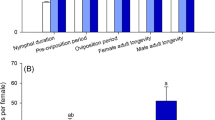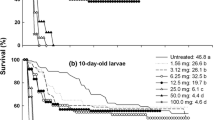Abstract
Apolygus lucorum (Meyer-Dür) (Hemiptera: Miridae) is currently one of major mirid pests in the Yangtze River and the Yellow River regions in China. Imidacloprid (neonicotinoid) is widely used against pierce-sucking pest insects, including against A. lucorum. In addition to its direct lethal effect, multiple negative sublethal effects may also occur in exposed insects. We assessed potential sublethal effects of imidacloprid on some biological characteristics of A. lucorum with the aim of increasing rational use of imidacloprid against that cotton pest. The lethal toxicity of imidacloprid on adults of A. lucorum was determined in laboratory conditions by a topical application bioassay (LD50 = 6.70 ng a.i. [active ingredient]/A. lucorum adult). We also estimated a sublethal dose, LD5 (0.38 ng a.i./adult), a low lethal dose, LD25 (1.96 ng a.i./adult), and moderate lethal dose, LD40 (3.97 ng a.i./adult). The sublethal dose of imidacloprid (LD5) shortened the pre-oviposition period of females but increased the time required for eggs to develop (i.e. longer embryogenesis). The low lethal dose (LD25) also reduced the pre-oviposition period. Females exposed to the LD40 laid eggs that developed faster but overall percentage of eggs hatching was reduced. LD25 and LD40 reduced longevity of males but not of females. In addition, the susceptibility to seven insecticides generally used on Chinese crops was not modified in A. lucorum previously exposed to the LD25 of imidacloprid. Our results demonstrate sublethal effects of low doses of imidacloprid on A. lucorum (notably on pre-oviposition period and egg development) which may have an impact on population dynamics of this pest.




Similar content being viewed by others
References
Arnó J, Gabarra R (2011) Side effects of selected insecticides on the Tuta absoluta (Lepidoptera: Gelechiidae) predators Macrolophus pygmaeus and Nesidiocoris tenuis (Hemiptera: Miridae). J Pest Sci 84:513–520
Bao HB, Liu SH, Gu JH, Wang XZ, Liang XL, Liu ZW (2009) Sublethal effects of four insecticides on the reproduction and wing formation of brown planthopper, Nilaparvata lugens. Pest Manag Sci 65:170–174
Biondi A, Desneux N, Siscaro G, Zappalà L (2012) Using organic-certified rather than synthetic pesticides may not be safer for biological control agents: selectivity and side effects of 14 pesticides on the predator Orius laevigatus. Chemosphere 87:803–812
Bonia DR, Onagbola EB, Salyani M, Lukasz L, Stelinskii LL (2009) Antifeedant and sublethal effects of imidacloprid on Asian citrus psyllid, Diaphorina citri. Pest Manag Sci 65:870–877
Bostanian NJ, Hardman JM, Ventard E, Racette G (2005) The intrinsic toxicity of several neonicotinoids to Lygus lineolaris and Hyaliodes vitripennis, a phytophagous and a predacious mirid. Pest Manag Sci 61:991–996
Cabral S, Soares AO, Garcia P (2011) Voracity of Coccinella undecimpunctata: effects of insecticides when foraging in a prey/plant system. J Pest Sci 84:373–379
Calabrese EJ, Baldwin LA (1998) Hormesis as a biological hypothesis. Environ Health Perspect 106:357–362
Calabrese EJ, Baldwin LA (2003) Toxicology rethinks its central belief––hormesis demands a reappraisal of the way risks are assessed. Nature 421:691–692
Chang J, Cao CW, Gao XW (2010) The effect of pretreatment with S,S,S-tributyl phosphorotrithioate on deltamethrin resistance and carboxylesterase activity in Aphis gossypii (Glover) (Homoptera: Aphididae). Pestic Biochem Phys 98:296–299
Cordeiro EMG, Corrêa AS, Venzon M, Guedes RNC (2010) Insecticide survival and behavioral avoidance in the lacewings Chrysoperla externa and Ceraeochrysa cubana. Chemosphere 81:1352–1357
Croft BA (1990) Arthropod biological control agents and pesticides. Wiley, New York
Cutler GC, Ramanaidu K, Astatkiec T, Ismana MB (2009) Green peach aphid, Myzus persicae (Hemiptera: Aphididae), reproduction during exposure to sublethal concentrations of imidacloprid and azadirachtin. Pest Manag Sci 65:205–209
Desneux N, Pham-Delègue MH, Kaiser L (2004a) Effects of sublethal and lethal doses of lambda-cyhalothrin on oviposition experience and host searching behaviour of a parasitic wasp, Aphidius ervi. Pest Manag Sci 60:381–389
Desneux N, Rafalimanana H, Kaiser L (2004b) Dose-response relationship in lethal and behavioural effects of different insecticides on the parasitic wasp Aphidius ervi. Chemosphere 54:619–627
Desneux N, Wajnberg E, Fauvergue X, Privet S, Kaiser L (2004c) Sublethal effects of a neurotoxic insecticide on the oviposition behaviour and the patch-time allocation in two aphid parasitoids, Diaeretiella rapae and Aphidius matricariae. Entomol Exp Appl 112:227–235
Desneux N, Fauvergue X, Dechaume-Moncharmont FX, Kerhoas L, Ballanger Y, Kaiser L (2005) Diaeretiella rapae limits Myzus persicae populations following applications of deltamethrin in oilseed rape. J Econ Entomol 98:9–17
Desneux N, Ramirez-Romero R, Kaiser L (2006a) Multi-step bioassay to predict recolonization potential of emerging parasitoids after a pesticide treatment. Environ Toxicol Chem 25:2675–2682
Desneux N, Denoyelle R, Kaiser L (2006b) A multi-step bioassay to assess the effect of the deltamethrin on the parasitic wasp Aphidius ervi. Chemosphere 65:1697–1706
Desneux N, Decourtye A, Delpuech JM (2007) The sublethal effects of pesticides on beneficial arthropods. Annu Rev Entomol 52:81–106
Devonshire AL, Field LM, Foster SP, Moores GD, Williamson MS, Blackman RL (1998) The evolution of insecticide resistance in the peach-potato aphid, Myzus persicae. Philos Trans R Soc London Ser B 353:1677–1684
Feyereisen R (1999) Insect P450 enzymes. Annu Rev Entomol 44:507–533
Fleury D, Bostanian NJ, Mauffette Y, Vincent C (2007) Residual toxicity of two insecticides on three field populations of Lygus lineolaris(Hemiptera: Miridae) collected along the St. Lawrence Valley in eastern Canada. Pest Manag Sci 63:495–499
Forbes VE (2000) Is hormesis an evolutionary expectation? Funct Ecol 14:12–24
Han P, Niu CY, Biondi A, Desneux N (2012) Does transgenic Cry1Ac+CpTI cotton pollen affect hypopharyngeal gland development and midgut proteolytic enzyme activity in the honey bee Apis mellifera L. (Hymenoptera, Apidae)? Ecotoxicology (accepted)
Han P, Niu CY, Lei CL, Cui JJ, Desneux N (2010a) Quantification of toxins in a Cry1Ac+CpTI cotton cultivar and its potential effects on the honey bee Apis mellifera L. Ecotoxicology 19:1452–1459
Han P, Niu CY, Lei CL, Cui JJ, Desneux N (2010b) Use of an innovative T-tube maze assay and the Proboscis Extension Response assay to assess sublethal effects of GM products and pesticides on learning capacity of the honey bee Apis mellifera L. Ecotoxicology 19:1612–1619
He YX, Zhao J, Zheng Y, Zhan Z, Desneux N, Wu KM (2012) Lethal effect of imidacloprid on the coccinellid predator Serangium japonicum and sublethal effects on predator voracity and on functional response to the whitefly Bemisia tabaci. Ecotoxicology. doi:10.1007/s10646-012-0883-6
James DG, Price TS (2002) Fecundity in two spotted spider mite (Acari: Tetranychidae) is increased by direct and systemic exposure to imidacloprid. J Econ Entomol 85:729–732
Kerns DL, Stewart SD (2000) Sublethal effects of insecticides on the intrinsic rate of increase of cotton aphid. Entomol Exp Appl 94:41–49
Lee CY, Yap HH, Chong NL (1998) Sublethal effects of deltamethrin and propoxur on longevity and reproduction of German cockroaches, Blattella germanica. Entomol Exp Appl 89:137–145
Li G, Feng H, McNeil JE, Liu B, Chen P, Qiu F (2011) Impacts of transgenic Bt cotton on a non-target pest, Apolygus lucorum (Meyer-Dür) (Hemiptera: Miridae), in northern China. Crop Prot 30:1573–1578
Liang P, Tian YA, Biondi A, Desneux N, Gao XW (2012) Short-term and transgenerational effects of the neonicotinoid nitenpyram on susceptibility to insecticides in two whitefly species. Ecotoxicology. doi:10.1007/s10646-012-0922-3
Liu ZW, Williamson MS, Lansdell SJ, Denholm I, Han ZJ, Millar NS (2005) A nicotinic acetylcholine receptor mutation conferring target-site resistance to imidacloprid in Nilaparvata lugens (brown planthopper). PNAS 102:8420–8425
Liu YQ, Lu YH, Wu KM, Wyckhuys KAG, Xue FS (2008) Lethal and sublethal effects of endosulfan on Apolygus lucorum (Hemiptera: Miridae). J Ecol Entomol 101:1805–1810
Lu YH, Qiu F, Feng HQ, Li HB, Yang ZC, Wyckhuys KAG, Wu KM (2008) Species composition and seasonal abundance of pestiferous plant bugs (Hemiptera: Miridae) on Bt Cotton in China. Crop Prot 27:465–472
Lu YH, Wu KM, Jiang YY, Xia B, Li P, Feng HQ, Wyckhuys KAG, Guo YY (2010) Mirid bug outbreaks in multiple crops correlated with wide-scale adoption of Bt cotton in China. Science 328:11151–11154
Lu YH, Wu KM, Jiang YY, Guo YY, Desneux N (2012) Widespread adoption of Bt cotton and insecticide decrease promotes biocontrol services. Nature. doi:10.1038/nature11153
Luttrell RG, Fitt GP, Ramalho FS, Sugonyaev ES (1994) Cotton pest management: Part 1. A woldwide perspective. Annu Rev Entomol 39:517–526
Matsuda K, Buckingham SD, Kleier D, Rauh JJ, Grauso M, Sattelle DB (2001) Neonicotinoids: insecticides acting on insect nicotinic acetylcholine receptors. Trends Pharmacol Sci 22:573–580
Nagy L, Grbić M (2009) Embryogenesis. In: Schowalter TD (ed) Insect ecology: an ecosystem approach, 2nd edn. Academic Press, London, pp 316–319
Nauen R, Koob B, Elbert A (1998) Antifeedant effects of sublethal dosages of imidacloprid on Bemisia tabaci. Entomol Exp Appl 88:287–293
Rahman MM, Roberts HLS, Sarjan M, Asgari S, Schmidt O (2004) Induction and transmission of Bacillus thuringiensis tolerance in the flour moth Ephestia kuehniella. PNAS 101:2696–2699
Ramirez-Romero R, Chaufaux J, Pham-Delègue MH (2005) Effects of Cry1Ab protoxin, deltamethrin and imidacloprid on the foraging activity and the learning performances of the honeybee Apis mellifera, a comparative approach. Apidologie 36:601–611
Ramirez-Romero R, Desneux N, Decourtye A, Chaffiol A, Pham-Delègue MH (2008) Does Cry1Ab protein affect learning performance of the honey bee Apis mellifera L. (Hymenoptera: Apidae)? Ecotox Environ Safe 70:327–333
Ruberson JR, Williams LH III (2000) Biological control of Lygus spp.: a component of areawide management. Southwest Entomol 23:96–100
Russell RM, Robertson JL, Savini NE (1977) POLO: a new computer program for probit analysis. Bull Entomol Soc Am 23:209–213
Scott JG, Georghiou GP (1986) Mechanisms responsible for high levels of permethrin resistance in house fly. Pestic Sci 17:195–206
Shahout HA, Xu JX, Qiao J, Jia QD (2011) Sublethal effects of Methoxyfenozide, in comparison to Chlorfluazuron and Beta-Cypermethrin, on the reproductive characteristics of common cutworm Spodoptera litura (Fabricius) (Lepidoptera: Noctuidae). J Entomol Res Soc 13:53–63
Sibly RM, Calow P (1986) Physiological ecology of animals, an evolutionary approach. Blackwell, Oxford
Stara J, Ourednickova J, Kocourek F (2011) Laboratory evaluation of the side effects of insecticides on Aphidius colemani (Hymenoptera: Aphidiidae), Aphidoletes aphidimyza (Diptera: Cecidomyiidae), and Neoseiulus cucumeris (Acari: Phytoseidae). J Pest Sci 84:25–31
Stark JD, Banks JE (2003) Population-level effects of pesticides and other toxicants on arthropods. Annu Rev Entomol 48:505–519
Terriere LC (1984) Induction of detoxication enzymes in insects. Annu Rev Entomol 29:71–88
Tomizawa M, Casida JE (2003) Selective toxicity of neonicotinoids attributable to specificity of insect and mammalian nicotinic receptors. Ann Rev Entomol 48:339–364
Wang XY, Yang ZQ, Shen ZR, Lu J, Xu WB (2008) Sublethal effects of selected insecticides on fecundity and wing dimorphism of green peach aphid. J Appl Entomol 132:135–142
Wu KM, Guo YY (2005) The evolution of cotton pest management practices in China. Annu Rev Entomol 50:31–52
Wu KM, Li W, Feng HQ, Guo YY (2002) Seasonal abundance of the mirids, Lygus lucorum and Adelphocoris spp. (Hemiptera: Miridae) on Bt cotton in northern China. Crop Prot 21:997–1002
Yu YS, Shen GQ, Zhu HL, Lu YT (2010) Imidacloprid-induced hormesis on the fecundity and juvenile hormone levels of the green peach aphid Myzus persicae (Sulzer). Pest Biochem Physiol 98:238–242
Zanuncio TV, Serrao JE, Zanuncio JC, Guedes RNC (2003) Permethrin-induced hormesis on the predator Supputius cincticeps (Stal 1860) (Heteroptera: Pentatomidae). Crop prot 22:941–947
Zappalà L, Siscaro G, Biondi A, Mollá O, González-Cabrera J, Urbaneja A (2012) Efficacy of sulphur on Tuta absoluta and its side effects on the predator Nesidiocoris tenuis. J Appl Ent. 136:401–409
Zeng CX, Wang JJ, Zeng ZP, Cao G (2006) Impact of sublethal doses of imidacloprid on experimental population of Myzus persicae. Plant Prot Sci 22:335–338
Zhang LP, Greenberg SM, Zhang YM, Liu TX (2011) Effectiveness of thiamethoxam and imidacloprid seed treatments against Bemisia tabaci (Hemiptera: Aleyrodidae) on cotton. Pest Manag Sci 67:226–232
Acknowledgments
The authors are grateful for the Institute of Plant Protection, the Chinese Academy of Agricultural Sciences for providing A. lucorum populations. This work was supported by National Basic Research Program of China (Contract no. 2012CB114103).
Conflict of interest
The authors declare that they have no conflict of interest.
Author information
Authors and Affiliations
Corresponding author
Rights and permissions
About this article
Cite this article
Tan, Y., Biondi, A., Desneux, N. et al. Assessment of physiological sublethal effects of imidacloprid on the mirid bug Apolygus lucorum (Meyer-Dür). Ecotoxicology 21, 1989–1997 (2012). https://doi.org/10.1007/s10646-012-0933-0
Accepted:
Published:
Issue Date:
DOI: https://doi.org/10.1007/s10646-012-0933-0




